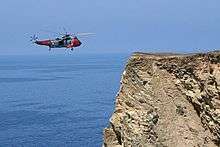Cornwall Search & Rescue Team

Cornwall Search and Rescue Team (formerly Cornwall Rescue Group) was set up in 2003 to provide inland search and rescue cover for the county of Cornwall, United Kingdom. As Cornwall has large areas of moorland this is an important part of the work.
History
The most southerly team in the British Isles is Cornwall Search and Rescue Team, however it has always had strong links with mountain rescue.
In 1965, Climbers’ Club custodian Jim Smith established the first mountain rescue post in the South West at the Carn Galver Count House at Bosigran in West Cornwall. Rescues at Bosigran, famed for its 200-metre climb “Commando Ridge” nicknamed after the World War II commandos who trained there in preparation for wartime cliff assaults, would be performed by other climbers who would go to the Count House to collect the rescue equipment.
Later, a subsidiary post was established in the Lands End climbing area and also the Liskeard area, however the coastal posts (including Lands End) closed around 20 years later as the HM Coastguard developed their cliff rescue capabilities. Similarly, the two voluntary mine rescue teams operating in the county disbanded in 1999 and 2008, after the fire brigade developed their mine rescue capabilities.
Until 2002, incidents in inland Cornwall and on the moors were dealt with by the rescue teams from Dartmoor and Exmoor. However, due to an increase in call outs, it was decided that Cornwall needed its own team and Cornwall SRT was formed, originally with the name of Cornwall Rescue Group.
Area covered
Cornwall has an area of about 3,500 square kilometres (1,400 sq mi) and the team covers all inland parts up to the border with Devon, with HM Coastguard covering the coastal areas. Although most of the county is farmland and semi-rural, over 300 square miles (780 km2) of this is open moorland including tors and lowland heath.
Although the team borders four other teams at the eastern end of the county, its promontory position means it has to be completely self-sufficient, being unable to rely on immediate help from neighbouring teams for incidents in the western parts of the team's area.
Workload
Since its formation, the team has continued to be one of the busier teams in the South West, dealing with between 40 and 60 callouts a year. Like a lot of teams around the country, many of these callouts are “non mountain rescue”—searching for vulnerable people in rural locations. However the team deals with its fair share of moorland jobs, mainly on and around Bodmin Moor, including casualty evacuations and rescue call outs directly from the ambulance service and the police (the size of the moor and vulnerability of inexperienced explorers making emergencies more probable).
Cornwall SRT is also occasionally called to assist during times of severe weather and during major incidents, having played a key role in the Boscastle flood and during heavy snowfall across the higher parts of Cornwall, e.g. in the winter of 2009/10. This is in addition to the more specialist roles which the team also has including the provision of casualty carers and technical specialists for fire service rope rescues.
Organisation
Led by a Team Leader and one deputy, the team currently has around 20 mine rescue team members and 45 surface search and rescue team members, based throughout Cornwall and one Search and Rescue Dog Association dog handler. Equipment is carried in three team vehicles which are based at Redruth, St Dennis and Bodmin. Two of these vehicles are Land Rover ambulances, and the other a control vehicle which also carries much of the technical equipment for CSRT’s mine rescue, and swiftwater search and rescue teams.
The team is an essential part of the emergency services across Cornwall and is a member of Mountain Rescue (England and Wales) and also the regional coordinating body - the Peninsular Mountain and Cave Rescue Association.
Team members train every Thursday evening at locations across Cornwall, and also one Sunday per month.
Funding
The team is a registered charity and survives entirely on charitable donations. Unlike the other emergency services, it receives no funding from the government, and on top of regular training and call outs, team members also have to organise fundraising activities to keep the team running.
External links
- Cornwall Search and Rescue Team
- Mountain Rescue (England and Wales)
- Search and Rescue Dog Association
- Charity Commission. Cornwall Rescue Group, registered charity no. 1100708.